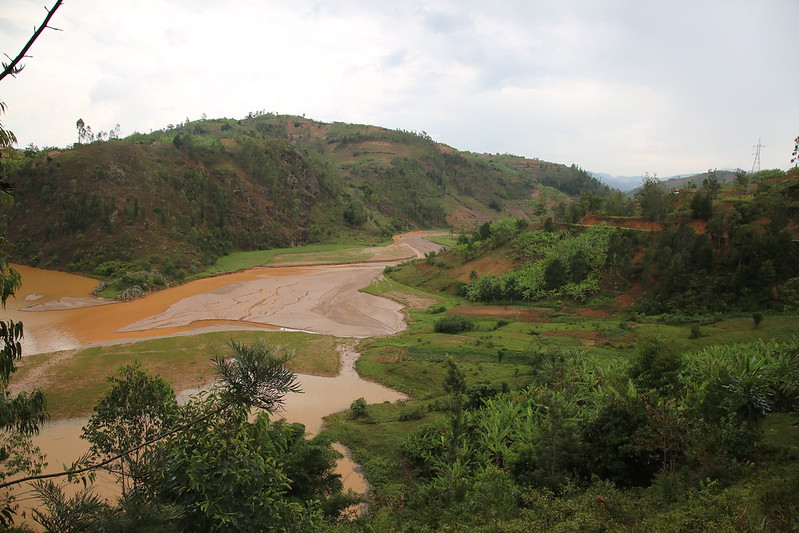Photo by Rwanda Green Fund on Flickr
How watershed management is improving community resilience in Rwanda and Uganda
Climate change is changing our water systems. Rising temperatures and erratic weather is leading to water scarcity, and polluted waterways. In Uganda and Rwanda, new approaches to managing waterways are promising a better future for water.
A
watershed is an area of land that drains rainfall and snowmelt into streams and rivers, which in turn run into lakes, seas, and oceans. Every body of water has a watershed, from tiny streams to great oceans, and they are the site of many important resources.
They are the source of water that we all use to drink, to nourish crops, and require for manufacturing; they provide homes to wildlife and can act as carbon sinks; intact floodplains can protect urban areas from flooding during extreme weather events; and watersheds can be a place for recreation.
Human impact on the environment has led to deteriorating watershed health around the world. As a result of intensive farming there are high rates of nitrogen and phosphorus from fertilisers in river systems, while the need for more farmland has led to deforestation that removes habitats, and allows greater amounts of sediment into waterways. Between 2000 and 3014, 6% of tree cover was lost from the world’s major watersheds.
Climate change is affecting watersheds, and impacting lives
Climate change has had broader impacts on watersheds. Rising temperatures and unpredictable weather patterns can affect the amount of water entering streams and rivers, the amount of sediment carried in surface runoff (and consequently, the level of pollutants carried into waterways), and has led to increased periods of drought, causing water scarcity.
Different watersheds will be affected by regional impacts of climate change. For example, rising temperatures can lead to the build-up of less snow in mountain areas, in turn meaning less snowmelt and a reduced water supply downstream. Or, where rainfall is erratic and very heavy, increased surface runoff overwhelms streams and rivers, leading to flooding. These impacts will affect the environment, humans, and animal life.
This is why it is vital we look after watersheds as climate change presents new and greater challenges. Watershed management is the management of the fields, forests, water resources and urban areas that cover the watershed area. Projects in Rwanda and Uganda are seeking to do just that.

Watersheds such as Nyabarongo, Rwanda are a life source but climate change and human behaviour is affecting them and their reliant environments. Photo by Rwanda Green Fund on Flickr.
In Rwanda, future planning can help combat water scarcity
The Water for Growth Rwanda (W4GR) is a joint, four-year project carried out by Rwanda with support from the Netherlands. The project seeks to establish policies and frameworks specific to local regions that would help with water conservation and management while enabling local farmers to continue to make a living. Through careful measurement and assessment, the project has developed a clear plan for 30% of the country’s land. This plan includes water allocation for irrigation, industry and domestic uses, and has contingency plans for periods of water scarcity. It is implemented through a mix of education, policy, and law making.
Another Rwandan project in the north-western highlands is the three-year Know Water Better project. It will test and develop new methods to better understand watersheds that use a mix of remote sensing, and data collection on the ground. Training will be given in water accounting and auditing – looking using data to work out demand on the water system, and the socio-political environment influencing decision making. The project aims to create a picture of the watershed that includes the environment, policy and socioeconomic impacts, which can then be used to inform better choices about watershed management. This project is also being rolled out in Senegal and Sri- Lanka.
In Uganda, local knowledge is invaluable to watershed management
Uganda has seen changes in rainfall patterns, extreme weather events, and floods, all as a result of climate change. These changes have led to failing crops, and threatened food security across the nation.
A policy of Integrated water resources management (IWRM) is being instituted nationally to manage and protect water resources. IWRM is an established method of water management. Within this, catchment management programmes tackle issues specific to a particular region’s water challenges.
The MWARES project is one such program dedicated to improving management of the Manafwa watershed on Uganda’s eastern border. The program seeks to engage and mobilise local populations and policy makers to introduce sustainable practise that conserve water and restore lost habitats. Farmers are actively involved in planning and decision making around issues such as crop and livestock practices. Goals include improvements to health and economic wellbeing, efficient use of natural resources, and protection of local communities from unpredictable weather patterns.
Stakeholder collaboration is key to watershed management
All these projects are attempting to bring together multiple layers of knowledge: cutting edge satellite technology, on the ground data collection, and the experience of farmers, local people, and policy makers. The goal is sustainable, resilient practices that protect watersheds, while enabling local people living and farming the land to make a living and maintain autonomy.
The ideas presented in this article aim to inspire adaptation action – they are the views of the author and do not necessarily reflect those of the Global Center on Adaptation.